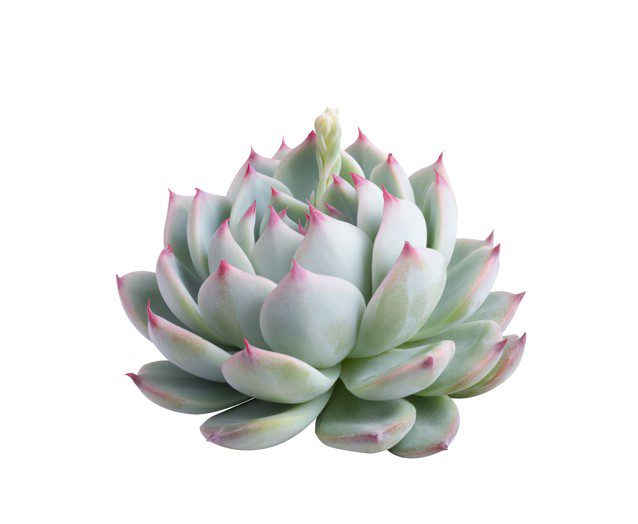Echeveria Elegans
The first thing you have to get over about Echeveria Elegans is that it is not hardy. People often confuse it with Sempervivum because the plants look vaguely the same, but attempts to grow them outside tend to be unsuccessful.
Two that are slightly hardy, in that they can withstand a seaside climate or protected situations, are Echeveria secunda var. glauca AGM and Echeveria secunda.
All other forms need some protection from frost. Echeveria varies in size from 15mm to 600mm across.
The dark-leaved forms tend to be popular, such as Echeveria ‘Black Prince’. But this is a hybrid of Echeveria affinis and, unfortunately, affinis stands for affinity to mealybug.
The best way to deal with mealybug is to examine the plants every week. If the infestation gets really bad, you have to treat it with a systemic insecticide.
Echeveria is grown for its foliage. The fleshy, symmetrical leaves make it an ideal house and glasshouse plant, but it works equally as well as a pot plant for sheltered patios.
Traditionally, Echeveria Elegans is used in carpet bedding. However, none of the species are hardy and need frost protection during the winter. Usually, the best way to provide this is to bring them under glass.
There are around 150 species, all predominantly found in Mexico but distributed across Central and South America.
Echeveria Elegans is named after Atanasio Echeverria Codoy; a botanical illustrator hired to work on the Flora Mexicans in 1789. Found in the Crassulaceae family, they are typically evergreen, though they can be deciduous.
Although Echeveria is succulent in nature, the genus is not found in desert regions. Echeveria is native to cool and fairly moist mountain areas.
Because of this, it tends to survive moderately cool temperatures of around 5°C. Cooler temperatures tend to bring out the best colors, and leaves tend to be at their brightest from autumn to spring.
Echeveria Elegans Growing And Care
Echeveria Elegans requires well-drained but humus-rich soil and those grown in soil-less mediums tend to grow leggy and over-succulent. Echeveria needs full sun and, when grown indoors, good ventilation to keep humidity down.
It is always preferable to water from below, as water tends to collect on the leaves and then roll into the plant’s crown, causing rot.
Echeveria needs plenty of water in the summer and very little in the winter. However, please do not leave it bone dry throughout the winter.
After some time, Echeveria tends to grow leggy as older leaves fall off, leaving a thick and usually ugly stem. Old Echeveria can be propagated by leaf-cutting in spring and early summer.
Choose plump, mature leaves and carefully detach them from the main plant. Cuttings should be laid on the surface of a sandy propagating medium in the shade.
Withhold water until roots appear when the cutting can be put into the soil and watered.
Many Echeveria varieties develop offset rosettes. These can be carefully divided and replanted. The terminal rosettes can also be removed and restarted the same way, with all dead and older leaves removed.
The old stem should be kept because it will often produce offsets from the top or side, removed and replanted. Echeveria can also be propagated from seed.
Echeveria can be prone to attacks from mealybug. Infected plants can be treated with a systemic insecticide drench. The genus can also be afflicted with orange rust, Endophyllum semperivi.
This appears as small orange clusters containing spores that cause the plants to lose their rosettes’ habits. Infected plants should be destroyed. Plants in the vicinity of infected material will need to be sprayed with a fungicide.
SPECIES AND CULTIVARS
* Echeveria agavoides Award of Garden Merit (AGM) has large, light green rosettes with red tips when grown in full sun.
* Echeveria ‘Black Prince’ is one of the darkest-leaved forms, with brown-tinged foliage and coral flowers.
* Echeveria derenbergii AGM forms a dense cushion of roughly cylindrical rosettes about six centimeters across. The waxy leaves are white on pale green and red-tipped, with reddish margins. The flowers are also reddish in late spring.
* Echeveria elegans AGM is a smaller species with pale green leaves. It is often used as a bedding plant.
* Echeveria gibbiflora var. cristata is a simple-stemmed or few-branched succulent with pointed, spoon-shaped, wavy leaves. The leaves are grey-green and often tinged reddish-brown. It produces red flowers that are yellow inside.
* Echeveria gibbiflora var. metallica AGM has white or red-margined, purple-green leaves maturing to green-bronze.
* Echeveria hamsii AGM is a bushy succulent with softly hairy branches. Each branch has a rosette of narrow, pointed, red-margined leaves, which are light green.
* Echeveria lilacina has short, thick stems with a large rosette. The rosettes consist of brownish-green leaves that are covered with a pinkish-white, wax-like powder. It produces clusters of pinkish-orange flowers in early summer, borne on the end of long, slender stems.
* Echeveria ‘Paul Bunyon’ has blue-grey, paddle-shaped leaves in rosettes on stout stems.
* Echeveria peacockii is a stemless or short-stemmed succulent with a dense rosette of slightly tapering, white-frosted leaves with red tips and margins. In early summer, it produces deep red-pink flowers.
* Echeveria pulvinata has a rosette of thick, fleshy oval leaves about five centimeters in length, which are covered in white hairs. The reddish flowers have prominent yellow stamens.
* Echeveria runyonii ‘TopsyTurvy’ is a popular cultivar of medium size with leaves peaked at the center.
* Echeveria secunda is a short-stemmed, clump-forming succulent with a dense basal rosette of spoon-shaped leaves that are blunt and bristle-tipped. The leaves are pale green, glaucous, and have red tips and margins.
* Echeveria setosaAGM has a stemless rosette of closely set, dark green leaves.


























